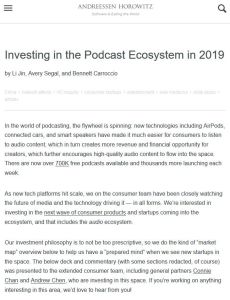
Li Jin, Avery Segal and Bennett Carroccio
Investing in the Podcast Ecosystem in 2019
A16Z, 2019
What's inside?
Silicon Valley–based venture capitalist firm Andreesen Horowitz is betting on podcasts.
Recommendation
More and more people are listening to podcasts, but the industry is still young. Venture capital firm Andreesen Horowitz’s Li Jin, Avery Segal and Bennett Carroccio have compiled insightful data about podcasting. The format, they say, is still evolving, and they foresee many possible developments. Their report will intrigue even those who think they know a lot about podcasts.
Take-Aways
- Podcast consumption is experiencing rapid growth, particularly among educated, affluent consumers.
- Podcasters aren’t yet tapping into the format’s full potential.
- Niche podcast production companies, translation and transcription services, AI-assisted content enrichment, and increased social interaction are possibilities for podcasting’s future.
- Chinese podcasting apps have incorporated interactive features and unique monetization schemes.
- Investors are enthusiastically funding new podcasting ventures but some believe the industry may be experiencing a bubble.
Summary
In the late 2000s, podcasts were a niche product. Since then, interest has grown rapidly. By early 2019, one-quarter of Americans tuned in weekly, and one-third listened at least monthly. Those who listen to podcasts spend more time listening each year, with weekly listeners now consuming around an hour of podcast content each day. The average listener is well-educated, about half earn more than $75,000 a year and about 44% are millennials. Investors deem the market ripe for investment, although observers warn that the industry may be overheating.
“Podcasts are most often consumed at home (48%) or in a car (26%); macro trends around growing numbers of connected cars and smart speakers could impact this mix.” ”
But podcasting still has potential for further development. Sean Rameswaram, host of the podcast Today, Explained, compares it to early video: “We’re still in the black-and-white period of podcasting. What’s color going to look like? What’s 3D going to look like?” How podcasts will evolve depends a lot on which features podcasting apps will support in the future. Meditation apps Calm and Headspace, for example, combine audio with other functions. Similarly, new niche audio apps might appear in areas like education, health or fitness. Other apps might add translation, transcriptions or visual enhancements. Podcasting app Entale, for example, incorporates AI to provide visual information related to the audio content, to link to web pages that provide more information or to place shopping links when a podcaster mentions a product.
“Roughly half of podcast listeners make $75,000 or more in annual income, a majority have a post-secondary degree, and almost one-third have a graduate degree.”
China’s equivalent of the US podcasting industry may hint at future developments. Most Western podcasting apps are fairly similar. In fact, most users don’t feel strongly about the app they use to load and listen to episodes. Chinese audio apps are more social, allowing users to make friends, interact during live audio broadcasts and tip producers. China’s Ximalaya has a pay-per-episode service – short content is around $0.03 – and offers audio courses that run from $10 to $45. Ximalaya also has a $3 subscription fee that allows a month of extensive access to more than 4,000 e-books and more than 300 premium podcasts and audio courses. Current US monetization models mostly rely on advertising or “off-platform donations.”
“The current state of monetization in podcasting mirrors the early internet: Revenue lags behind attention.”
Western podcasters monetize primarily via advertising. But even though advertisers believe in the value of podcast commercials, apps have yet to find smooth pathways to shuttle the user from the listening experience to the brand experience. Currently, the process for listeners who decide to buy an advertised product or engage with a brand they hear about is “manual and tedious.” User-paid premium content and subscriptions will likely become more relevant monetization models in the future.
About the Authors
Li Jin and Bennett Carroccio are partners at venture capital firm Andreesen Horowitz, where Avery Segal works as a researcher.
This document is restricted to personal use only.
My Highlights
Did you like this summary?
Read the articleThis summary has been shared with you by getAbstract.
We find, rate and summarize relevant knowledge to help people make better decisions in business and in their private lives.
Already a customer? Log in here.
















Comment on this summary